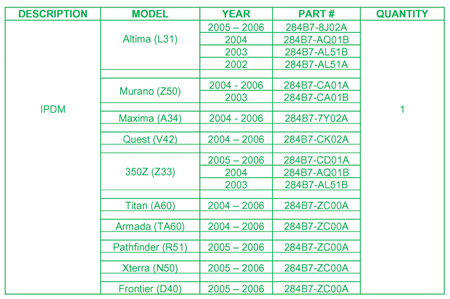Confirm a “no crank” (starter doesn’t work) incident under all of the following conditions:
1. The vehicle sat for several hours (cold soak) with outside temperatures below 10° F (12° C).
2. The vehicle was then driven for a short period of time (5-10 minutes).
3. The engine was then turned off for a short time (5-10 minutes).
4. The engine would then not crank when a restart was attempted (starter doesn’t work).
Note: This TSB applies only if all of the above conditions occurred.
Applied Vehicles:
• 2002-’06 Altima (L31);
• 2004-’06 Maxima (A34);
• 2004-’06 Quest (V42);
• 2003-’06 Murano (Z50);
• 2003-’06 350Z (Z33);
• 2004-’06 Titan (A60);
• 2004-’06 Armada (TA60);
• 2005-’06 Pathfinder (R51);
• 2005-’06 Xterra (N50); and
• 2005-’06 Frontier (D40).
Action:
Replace the Intelligent Power Distribution Module-IPDM (see chart). For IPDM replacement information, go to the Service Manual, section PG, Removal and Installation of IPDM E/R.
Technical service bulletin courtesy of Mitchell 1.
For more information on Mitchell 1 products and services, automotive professionals can log onto the company’s website at www.mitchell1.com.







